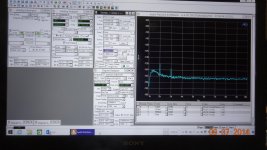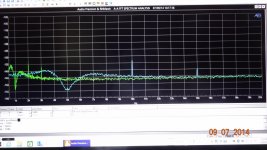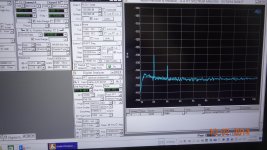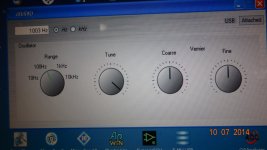Yes it is.
But I cant get your file to open on Win8. BUT, I installed it on my old XP and it is working!?
We can figure it out later.
THx-RNMarsh
Sure. You can try the oscillator on your XP machine.
You can open the folder on the CD with your file manager. Click on the folder Application GUI. In that folder there is another folder named X86. Try that version of the build. it will run as a 32 bit app on a 64 bit machine.
Work in progress - status:
Ok I will try that. I am running your osc from the XP and running the Audio-Prec from the WIN8 machine.
So far I learned the 2H can be as low as -135dB with 3H at -138dB (1KHz). These are very good numbers. Also, there is very short settling times for all freq including low freqs.
The distortion is a little higher on some ranges... something for you to look at, perhaps.
I'll get more info to you by regular email until the prototype is the way you like it.
THx-RNMarsh
 1KHz
1KHz
 1KHz and 5KHz
1KHz and 5KHz
Ok I will try that. I am running your osc from the XP and running the Audio-Prec from the WIN8 machine.
So far I learned the 2H can be as low as -135dB with 3H at -138dB (1KHz). These are very good numbers. Also, there is very short settling times for all freq including low freqs.
The distortion is a little higher on some ranges... something for you to look at, perhaps.
I'll get more info to you by regular email until the prototype is the way you like it.
THx-RNMarsh
 1KHz
1KHz 1KHz and 5KHz
1KHz and 5KHz
Last edited:
Comparing to resistive tuning the Mdacs seem to exhibit a slightly higher distortion depending on the output current of the dacs. When the dacs are closer to their extremes the distortion
decreases. Therefore for the same frequency and different range overlap the distortion may be different.
I do observe distortion differences in different range overlapping with other oscillators.
339A for example.
Another possibility is that if you're at the residual of the analyzer the sum-difference of phase of the harmonic between oscillator and analyzer might be showing their face. ther can be phase differences between same frequency in different ranges.
decreases. Therefore for the same frequency and different range overlap the distortion may be different.
I do observe distortion differences in different range overlapping with other oscillators.
339A for example.
Another possibility is that if you're at the residual of the analyzer the sum-difference of phase of the harmonic between oscillator and analyzer might be showing their face. ther can be phase differences between same frequency in different ranges.
What about THD+N?
Samuel
On this range and this level and freq.... about -113dB
(all outputs are from the 0 degree output or the BNC on the right)
[Open the top/first picture by clicking on it. then click again for magnification. Then move the curser around with the mouse show the details of the analyzer display.... there is a THD+N window showing about -113]
The notch from the A-P is showing -155dB.
THx-RNMarsh
Last edited:
Ok I will try that. I am running your osc from the XP and running the Audio-Prec from the WIN8 machine.
So far I learned the 2H can be as low as -135dB with 3H at -138dB (1KHz). These are very good numbers. Also, there is very short settling times for all freq including low freqs.
The distortion is a little higher on some ranges... something for you to look at, perhaps.
I'll get more info to you by regular email until the prototype is the way you like it.
THx-RNMarsh
View attachment 427947 1KHz
View attachment 427946 1KHz and 5KHz
Is a flat top window what you normally use for FFT in the AP?
Very low distortion --
Here is the FFT of 2H and 3H on the 100Hz range but still 1KHz.
I noticed something.... at levels far below -100dB the noise is beginning to have its affect.... namely, that the A-P doesnt always recognize a small change in osc freq. If I just change 1000 hz by +/- 3 hz, the AP may not track it and the Harmonic level being shown can go up .... using the 3H first. But sometimes, both can be up a lot more than is real. So, gentle people, we are near the measurement limits for accuracy.
What you see is from my 'bumping' the A-P notch filter back and forth until it was stuck at the center of the osc freq and thus the lowest distortion results.

Thx- RNMarsh
Here is the FFT of 2H and 3H on the 100Hz range but still 1KHz.
I noticed something.... at levels far below -100dB the noise is beginning to have its affect.... namely, that the A-P doesnt always recognize a small change in osc freq. If I just change 1000 hz by +/- 3 hz, the AP may not track it and the Harmonic level being shown can go up .... using the 3H first. But sometimes, both can be up a lot more than is real. So, gentle people, we are near the measurement limits for accuracy.
What you see is from my 'bumping' the A-P notch filter back and forth until it was stuck at the center of the osc freq and thus the lowest distortion results.

Thx- RNMarsh
These are indeed very good numbers. Congratulations.
I think in a real world environment, the AP is reliable down to about -114 dB. The measurement part is better, so the figure I quote is system performance.
Yes, if talking about THD+N.... A-P spec says it is 'typically' less than -115dB.
David's software frequency control panel via USB. ->

THx-RNMarsh
Last edited:
I noticed something... At levels far below -100dB the noise is beginning to have its affect... Namely, that the A-P doesnt always recognize a small change in osc freq.
The counter (which is used for the coarse notch frequency tuning, usually) will stop working correctly at very low levels. The auto-tuning might still track the signal frequency, but as it tunes further from the nominal frequency, the distortion increases. That's probably a result of the used multiplier--I don't know what they use.
Samuel
Good Stuff!
Thank you Dave, This was fun project to do.
The counter (which is used for the coarse notch frequency tuning, usually) will stop working correctly at very low levels.
Samuel
Then some extra amplification used for very low levels to the counter would help?? Or, is that too much over-simplified.
THx-RNMarsh
Last edited:
- Home
- Design & Build
- Equipment & Tools
- Low-distortion Audio-range Oscillator